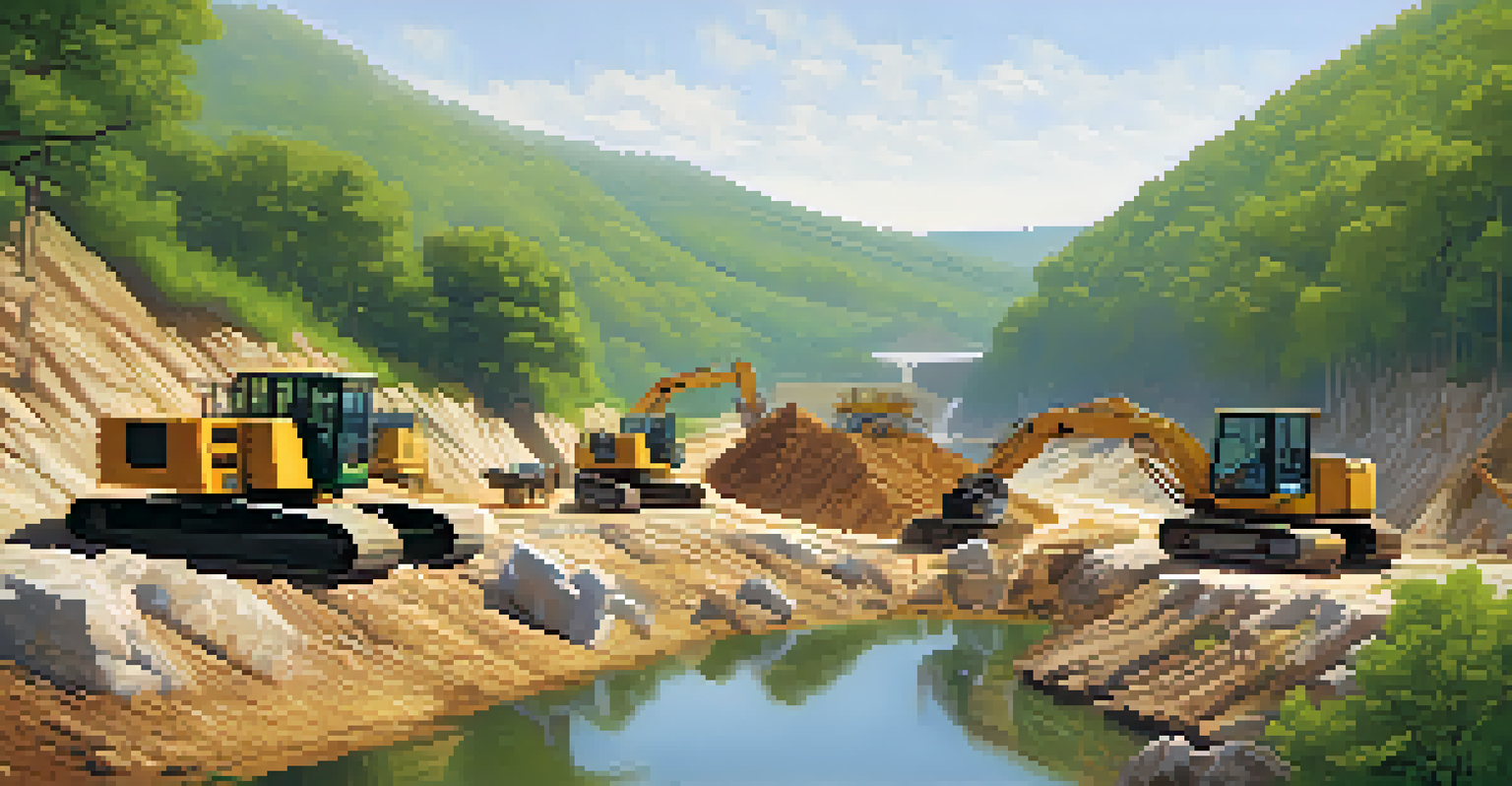The Impact of Stone Carving on Natural Resources

Understanding Stone Carving and Its Materials
Stone carving is the art of shaping stone into functional or decorative forms. It involves various materials such as marble, granite, and limestone, each with unique properties. The choice of stone influences not only the final product's aesthetics but also the environmental impact of the extraction process.
The Earth does not belong to us; we belong to the Earth.
The tools and techniques used in stone carving have evolved over centuries, but the core principle remains the same: transforming raw materials into art. This transformation can sometimes lead to significant resource depletion, particularly when demand for certain stones surges. Understanding the balance between artistry and sustainability is crucial.
As artisans continue to explore new forms and techniques, it's essential to consider how these practices affect our planet. The extraction of stone can lead to habitat destruction, increased carbon emissions, and other environmental concerns. By acknowledging these impacts, we can work towards more sustainable practices in stone carving.
The Environmental Costs of Stone Extraction
Extracting stone from quarries often involves significant environmental costs. The process can lead to deforestation, soil erosion, and disruption of local ecosystems. For instance, the removal of large amounts of earth can alter water drainage patterns, affecting both land and wildlife.

Furthermore, quarrying operations can generate dust and noise pollution, impacting surrounding communities. The machinery used in extraction also contributes to greenhouse gas emissions. These factors highlight the need for more responsible sourcing and extraction methods in the stone carving industry.
Sustainability in Stone Carving
Emphasizing the need for sustainable practices, the stone carving industry can minimize environmental impacts through the use of reclaimed materials and eco-friendly techniques.
As consumers and artists become more aware of these issues, there is a growing push for sustainable practices. This includes using recycled stone, sourcing materials locally, and supporting companies that prioritize environmentally friendly methods. By making informed choices, we can help mitigate the environmental impact of stone carving.
Sustainable Practices in Stone Carving
Sustainable practices in stone carving focus on minimizing environmental impact while maximizing artistry. One effective approach is the use of reclaimed stone, which reduces the need for new extraction and helps preserve natural resources. Artists can create beautiful pieces using materials that would otherwise go to waste.
Sustainability is not a destination; it is a journey.
Another sustainable method is the implementation of eco-friendly quarrying techniques. These methods are designed to reduce waste and lower emissions, such as using water-based dust suppression systems. By adopting these practices, the industry can significantly lessen its ecological footprint.
Additionally, education plays a vital role in promoting sustainability within the stone carving community. Workshops and resources can help artisans understand the impact of their choices and encourage them to adopt more environmentally responsible practices. Together, these efforts can pave the way for a more sustainable future in stone carving.
The Role of Technology in Stone Carving
Technology has revolutionized the stone carving industry, offering new tools and techniques that enhance efficiency and precision. For instance, computer numerical control (CNC) machines allow for intricate designs that were once impossible to achieve by hand. This technology not only saves time but also reduces material waste.
Moreover, advancements in digital design software enable artists to visualize their creations before starting the carving process. This can lead to more informed decisions about material use and design, ultimately promoting sustainability. The integration of technology in stone carving represents a shift towards modern artistry while addressing resource concerns.
Technology Enhances Artistry
Advancements in technology, such as CNC machines and digital design software, improve efficiency and precision in stone carving while promoting sustainability.
However, it's essential to balance technological advancement with traditional craftsmanship. While machines can enhance productivity, the unique touch of an artisan's hand is irreplaceable. Striking this balance can help preserve the rich heritage of stone carving while embracing the future.
Case Studies: Successful Sustainable Stone Projects
Several successful projects exemplify sustainable practices in stone carving. For example, a renowned artist created a series of sculptures using reclaimed marble sourced from old buildings. This not only reduced waste but also added historical significance to the artwork, showcasing the beauty of recycling.
Another inspiring case is a quarry that transitioned to eco-friendly extraction methods. By implementing water conservation strategies and minimizing land disturbance, they were able to significantly reduce their environmental impact while maintaining productivity. Such initiatives prove that sustainability and profitability can go hand in hand.
These case studies serve as powerful reminders of the potential for positive change within the stone carving industry. They demonstrate that artists and companies can work together to create beautiful works of art while prioritizing the health of our planet.
The Future of Stone Carving and Natural Resources
The future of stone carving is closely tied to our approach to natural resources. As awareness of environmental issues grows, artists and consumers alike are demanding more sustainable practices. This shift presents an opportunity for innovation within the industry, as new techniques and materials are explored.
One potential avenue is the increased use of alternative materials, such as concrete or composite stones that mimic the look of natural stone without the same environmental impact. These materials can provide artists with new creative possibilities while helping to conserve natural resources.
Future of Stone Carving
The future of stone carving relies on a commitment to sustainable practices and innovation, exploring alternative materials and responsible sourcing.
Ultimately, the future of stone carving will depend on a collective commitment to sustainability. By prioritizing responsible practices and fostering a culture of environmental awareness, we can ensure that this ancient art form continues to thrive while respecting our planet's precious resources.
Conclusion: Balancing Artistry with Responsibility
In conclusion, the impact of stone carving on natural resources is a complex interplay of artistry and responsibility. As artisans create beautiful pieces, they must also consider the environmental consequences of their choices. This balance is crucial for the sustainability of both the art form and the planet.
By embracing sustainable practices, exploring innovative materials, and leveraging technology, the stone carving industry can minimize its ecological footprint. Artists have the power to inspire change, and every decision they make can contribute to a more sustainable future.

As we move forward, it’s essential for both creators and consumers to remain informed and engaged in conversations about sustainability. Together, we can celebrate the beauty of stone carving while ensuring that our natural resources are protected for generations to come.